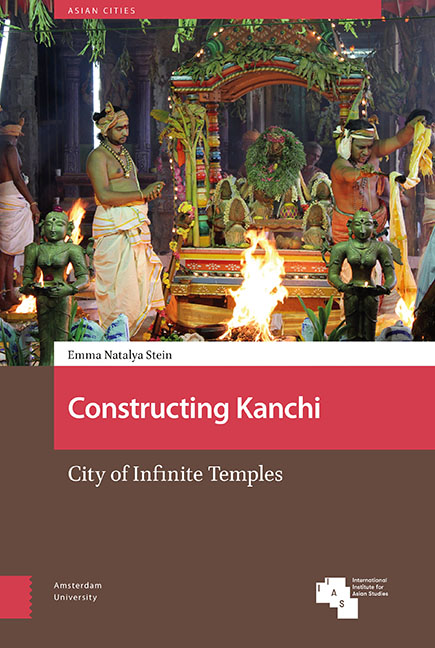Book contents
- Frontmatter
- Dedication
- Table of Contents
- Acknowledgments
- List of Illustrations
- Note on Transliteration, Translation, and Illustrations
- Introduction: All Streets Lead to Temples
- 1 Sandstone and the City: Building Pallava-Kanchi (ca. seventh through ninth century)
- 2 Realignment: Kanchi in the Chola Era (ca. tenth through thirteenth century)
- 3 The City and its Ports
- 4 Kanchi Under Colonialism
- Epilogue: The Living Temple
- Bibliography
- Index
Epilogue: The Living Temple
Published online by Cambridge University Press: 16 December 2021
- Frontmatter
- Dedication
- Table of Contents
- Acknowledgments
- List of Illustrations
- Note on Transliteration, Translation, and Illustrations
- Introduction: All Streets Lead to Temples
- 1 Sandstone and the City: Building Pallava-Kanchi (ca. seventh through ninth century)
- 2 Realignment: Kanchi in the Chola Era (ca. tenth through thirteenth century)
- 3 The City and its Ports
- 4 Kanchi Under Colonialism
- Epilogue: The Living Temple
- Bibliography
- Index
Summary
Encounter
It is a pleasant evening in October 2013, day four in my first week of fieldwork. I wander through the rain-soaked streets of Kanchi, where sprawling puddles make mud that sticks to my feet and shoes. I’m on my way to check on the Kauśikeśvara temple, a single-storey granite structure behind a gate that has been locked each time I visited. I wonder if it is ever open. The Archaeological Survey of India's official green fence and blue signboard had already become my touchstones for preserved monuments, but none of the ASI monument attendants in Kanchi seemed to know anything about a temple with this name. The gate is locked as usual.
‘Kauśikeśvara’, as it is written on the banner over the entry to the temple grounds, is a local name. Cokkīśvara is the name written on the blue sign, which is tucked inconspicuously behind the locked gate. Cokkīśvara is indeed under the auspices of the ASI, but the temple boasts no monument attendant. It is situated in the front yard of a large house, and a privately hired watchman guards the property. While the banner presents the local title, the blue signboard posts the temple's historic name. The date is given as the ninth century in both labels. However, the blue signboard attributes the temple to the reign of Uttama Cōḻa, who in fact ruled in the tenth century (ca. 969-985 CE).
The confusion in names and dates that I encountered almost immediately upon arrival in Kanchi reveals some of the dynamics at play in a living city with temples that range in condition from preserved monuments to active ritual centers. Whereas some temples enjoy continuous endowments for their maintenance, the lives of others progress cyclically, with periods of relative disuse interleaved with periods of prominence. Some temples have become all but stripped of their sacrality through conservation efforts by the ASI. Others have had their ritual functions diminished due to neglect rather than monumentification. Still others have endured as relatively private spaces for devotion. The largest and most popular temples in the city also have been subjected to change.
- Type
- Chapter
- Information
- Constructing KanchiCity of Infinite Temples, pp. 267 - 274Publisher: Amsterdam University PressPrint publication year: 2021



